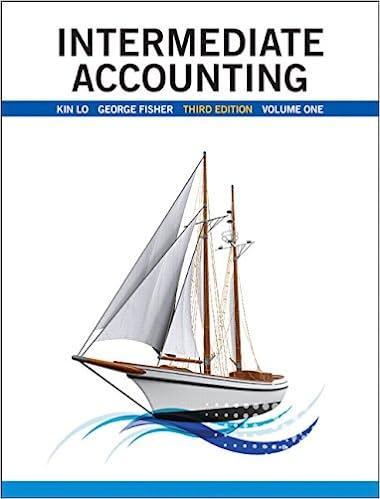Answered step by step
Verified Expert Solution
Question
1 Approved Answer
The following events apply to Adams Manufacturing Company. Assume that all transactions are cash transactions unless otherwise indicated. Transactions for the Year 1 Accounting Period




The following events apply to Adams Manufacturing Company. Assume that all transactions are cash transactions unless otherwise indicated.
Transactions for the Year 1 Accounting Period
- The company was started on January 1, Year 1, when it acquired $145,000 cash by issuing common stock.
- The company purchased $35,000 of direct raw materials with cash and used $2,230 of these materials to make its products in January.
- Employees provided 950 hours of labor at $5.00 per hour during January. Wages are paid in cash.
- The estimated manufacturing overhead costs for Year 1 were $56,870. Overhead is applied on the basis of direct labor hours. The company expected to use 12,100 direct labor hours during Year 1. Calculate an overhead rate and apply the overhead for January to work in process inventory.
- The employees completed work on all inventory items started in January. The cost of this production was transferred to the Finished Goods Inventory account. Determine the cost per unit of product produced in January, assuming that a total of 1,635 units of product were started and completed during the month.
- The company used an additional $27,480 of direct raw materials and 11,600 hours of direct labor at $5.00 per hour during the remainder of Year 1. Overhead was allocated on the basis of direct labor hours.
- The company completed work on inventory items started between February 1 and December 31, and the cost of the completed inventory was transferred to the Finished Goods Inventory account. Determine the cost per unit for goods produced between February 1 and December 31, assuming that 20,000 units of inventory were produced. If the company desires to earn a gross profit of $2.50 per unit, what price per unit must it charge for the merchandise sold?
- The company sold 19,000 units of inventory for cash at $9.50 per unit. Determine the number of units in ending inventory and the cost per unit incurred for this inventory.
- Actual manufacturing overhead costs paid in cash were $57,770.
- The company paid $37,900 cash for selling and administrative expenses.
- Close the Manufacturing Overhead account.
- Close the revenue and expense accounts.
Transactions for the Year 2 Accounting Period
- The company purchased $50,000 of direct raw materials with cash and used $3,360 of these materials to make products in January.
- Employees provided 800 hours of labor at $5.00 per hour during January.
- On January 1, Year 2, Adams hired a production supervisor at an expected cost of $1,050 cash per month. The company paid cash to purchase $3,500 of manufacturing supplies; it anticipated that $3,145 of these supplies would be used by year-end. Other manufacturing overhead costs (production supplies) were expected to total $56,870. Overhead is applied on the basis of direct labor hours. Adams expected to use 14,100 hours of direct labor during Year 2. Based on this information, determine the total expected overhead cost for Year 2. Calculate the predetermined overhead rate and apply the overhead cost for the January production.
- The company recorded a $1,050 cash payment to the production supervisor.
- The employees completed work on all inventory items started in January. The cost of this production was transferred to the Finished Goods Inventory account. Determine the cost per unit of product produced in January, assuming that 1,435 units of product were started and completed during the month.
- During February Year 2, the company used $3,515 of raw materials and 1,100 hours of labor at $5.00 per hour. Overhead was allocated on the basis of direct labor hours.
- The company recorded a $1,050 cash payment to the production supervisor for February.
- The employees completed work on all inventory items started in February; the cost of this production was transferred to the Finished Goods Inventory account. Determine the cost per unit of product produced in February, assuming that 1,835 units of product were started and completed during the month.
- The company used an additional $45,185 of direct raw materials and 12,100 hours of direct labor at $5.00 per hour during the remainder of Year 2. Overhead was allocated on the basis of direct labor hours.
- The company recorded $10,500 of cash payments to the production supervisor for work performed between March 1 and December 31.
- The company completed work on inventory items started between March 1 and December 31. The cost of the completed goods was transferred to the Finished Goods Inventory account. Compute the cost per unit of this inventory, assuming that there were 21,000 units of inventory produced.
- The company sold 23,000 units of product for $10.00 cash per unit. Assume that the company uses the FIFO inventory cost flow method to determine the cost of goods sold.
- The company paid $38,000 cash for selling and administrative expenses.
- As of December 31, Year 2, $445 of production supplies was on hand.
- Actual cost of other manufacturing overhead was $56,000 cash.
- Close the Manufacturing Overhead account.
- Close the revenue and expense accounts.
Required
- Post the above transactions for both years to the appropriate T-accounts.
- Prepare a schedule of cost of goods manufactured and sold, an income statement, and a balance sheet for each year.




Step by Step Solution
There are 3 Steps involved in it
Step: 1

Get Instant Access to Expert-Tailored Solutions
See step-by-step solutions with expert insights and AI powered tools for academic success
Step: 2

Step: 3

Ace Your Homework with AI
Get the answers you need in no time with our AI-driven, step-by-step assistance
Get Started


